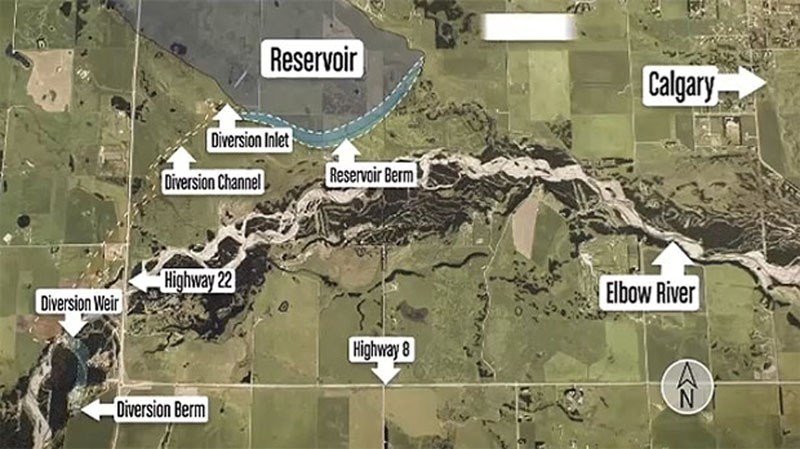ROCKY VIEW— A report released from the Impact Assessment Agency of Canada indicates the environmental impact of the Springbank Off-Stream Reservoir will be minimal.
The Impact Assessment Agency released a draft environmental report regarding the reservoir, also known as SR1, in early January.
The report concluded, "taking into account the implementation of mitigation measures, the Project is not likely to cause significant adverse residual environmental effects."
The SR1 project was initially announced by the Alberta government in 2014 as a flood mitigation effort. The project was deemed necessary in the aftermath of the once in a lifetime flood of 2013.
The proposed $432 million reservoir will be built about 15 km west of Calgary on the Elbow River and occupy around 3,870 acres. The area was chosen by the provincial government because it offers flood protection for the City of Calgary and Rocky View County, has a limited environmental impact and provides easy access to operational response teams and access roads.
The SR1 system will work to control how much flood water enters the river through the use of a diversion channel and the design is built to accommodate water levels matching the 2013 flood.
While the City of Calgary has largely been in favour of SR1, the project has received backlash from other stakeholders over the years, including residents in Springbank, Bragg Creek and the Tsuut’ina First Nation.
"The political will behind this project has always been tremendous,” said Karin Hunter, the president of the Springbank Community Association, which has opposed the project. “Is it inevitable? No, I don't think so. The provincial regulator has to look and test if it is in the public good.
"If I ask the question, is this in the public good for Calgary? The answer might be yes— I don't know, as I can think of a bunch of reasons this is terrible for Calgary— But, is this in the public interest of southern Alberta? I think it's a no."
Hunter said she believes when looking back on the project it will be viewed as a waste of land, economic and water resources.
"Certainly, this project is not getting simpler,” Hunter said. “It was always pegged as being fast and easy, and a quick win, but it's not.”
Hunter said Springbank Community Association members intend to submit further feedback at a hearing hosted by Alberta’s Natural Resources Conservation Board in March. She added while the Impact Assessment Agency of Canada's report may have concluded the project does not pose environmental risks, area residents would still be largely affected.
"We've only ever asked for one thing from the Alberta government, and it's transparency about the social and economic cost,” she said. “It's disappointing that our own County elects to make an agreement with very little transparency, without consultation with the community that is most impacted."
Rocky View County council initially voted to formally oppose the project in December 2018. However, council voted 6-3 to withdraw its opposition in May 2020.
The following month, Rocky View County announced an agreement with the Alberta government to receive compensation for any lost revenue should the project be completed. According to a Rocky View County press release, the County would receive $10 million from the provincial government to address any future loss of municipal property taxes on the 3,870 acres of land that would be impacted if SR1 proceeds.
Rocky View County Councillor Mark Kamachi said, while Rocky View County stepped back from opposing SR1, he remains against the project.
He expects some residents in the county will challenge the results of the federal study and more public consultation will take place regarding SR1.
“There are still others out there who are still trying to get more studies done from other independent firms,” Kamachi said.
He added his ultimate goal is to ensure the right solution based on the right research, data and facts is being used in the creation of flood mitigation in Rocky View County.
“If SR1 dies then so be it, then we look at something like a McLean Creek or another option,” Kamachi said.
While the project has been met with pushback from the community, he said, there is now a sense of relief seeing the berms and flood mitigation being put in place.
The flood mitigation along the section of the Elbow River running through Bragg Creek was important because if the SR1 fails to become a reality there will be some type of flood protection in place for Bragg Creek, Redwood Meadows and Tsuut’ina First Nation.
Another former opponent of the project that reversed course last year was the Tsuut'ina First Nation, which announced in April 2020 it would formally withdraw its opposition to the reservoir.
In a statement provided to The Cochrane Eagle, Banff-Kananaskis MLA Miranda Rosin said she was surprised to learn of the Impact Assessment Agency of Canada's findings.
"While I found it surprising to hear that the Impact Assessment Agency believes it unlikely for the Springbank Off-Stream Reservoir to have any adverse environmental effects on the region, this is good news," she said in a statement. "Some of the primary concerns myself and the residents of the Springbank area have raised over the years have been in relation to the project’s potential harm to air, land, and water quality of the community, so the release of this report is somewhat reassuring."
However, Rosin added she was still disappointed to see the socioeconomic impacts of the project on Springbank, Bragg Creek and surrounding area residents were not addressed.
"I know that for those living in these communities, much remains unsettled after the release of this report and people still feel very concerned," she said. "I'll continue doing my best to ensure those concerns are not only heard, but brought to Edmonton and addressed."
—With files from Scott Strasser/Airdrie City View




